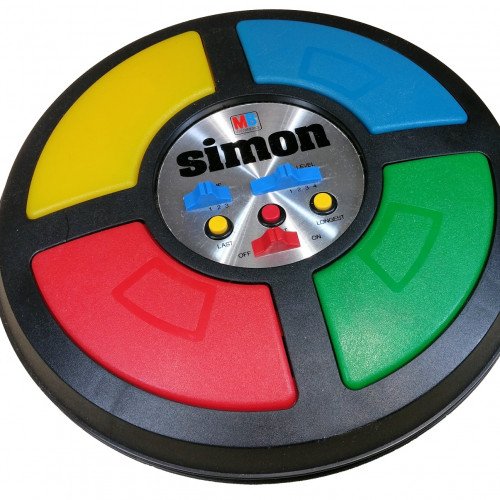SIMON VS SUGOROKU

SIMON
Simon is an electronic game of memory skill invented by Ralph H. Baer and Howard J. Morrison, working for toy design firm Marvin Glass and Associates, with software programming by Lenny Cope. The device creates a series of tones and lights and requires a user to repeat the sequence. If the user succeeds, the series becomes progressively longer and more complex. Once the user fails or the time limit runs out, the game is over. The original version was manufactured and distributed by Milton Bradley and later by Hasbro after it took over Milton Bradley. Much of the assembly language code was written by Charles Kapps, who taught computer science at Temple University and also wrote one of the first books on the theory of computer programming. Simon was launched in 1978 at Studio 54 in New York City and was an immediate success, becoming a pop culture symbol of the 1970s and 1980s. Ralph H. Baer and Howard J. Morrison were introduced to Atari's arcade game Touch Me at the Music Operators of America (MOA) trade show in 1976. Baer said of the product, "Nice gameplay. Terrible execution. Visually boring. Miserable, rasping sounds." The prototype built by Baer used the low cost Texas Instruments TMS 1000 microcontroller chip, which was in many games of the 1970s. Lenny Cope, who was one of Ralph H. Baer's partners, programmed the core of the game, titled Follow Me at the time. Baer developed the tones of the game, inspired by the notes of a bugle. When they pitched the demo, an 8-by-8-inch console, to the Milton Bradley Company the name of the game was changed to Simon. Simon debuted in 1978 at a retail price of $24.95 (equivalent to $98 in 2019) and became one of the top-selling toys that Christmas. U.S. Patent 4,207,087: "Microcomputer controlled game", was granted in 1980. Milton Bradley soon capitalized on the original with both the smaller-sized Pocket Simon and the expanded, eight-button Super Simon. Many variants of Simon have been made since Hasbro acquired Milton Bradley in the 1980s, building on the possibilities offered by advances in technology. The original Super Simon was reinvented in the late 1990s as a hexagonal unit with six buttons. 2000 saw Simon Squared (or Simon2), a unit with the four traditional buttons on one side, and a set of eight smaller buttons on the other. In 2004, Hasbro released the Simon Stix. The game features two electronic sticks (modeled after drumsticks), an emphasis on the musical part of the game, and features four levels of play. In 2005, Hasbro released Simon Trickster (also known as Simon Tricks in Europe and in the UK, and as Simon Genius in Brazil), which features four game modes, in a similar fashion to another Hasbro game, Bop It, and colored lenses instead of buttons. "Simon Classic" mode plays up to 35 tones(notes). "Simon Bounce" is similar to "Simon Classic", but instead the colors of the lenses change. "Simon Surprise" is one of the most difficult games in the unit. Every lens becomes the same color and the player has to memorize the location. "Simon Rewind" requires the player to memorize the sequence backwards. During each game, the player is paid a compliment after a certain number of tones completed. On reaching five and eleven tones, the computer will randomly choose "Awesome!", "Nice!", "Sweet!" or "Respect!". On reaching 18 tones, the game will play a victory melody three times. On reaching the ultimate 35 tones, the game will play the victory melody again and will say "Respect!". If the player fails to memorize the pattern or fails to press the right color within the time limit, the game will play a crashing sound and the game will say "Later!".
Statistics for this Xoptio

SUGOROKU
Sugoroku (雙六 or 双六) (literally 'double six') refers to two different forms of a Japanese board game: ban-sugoroku (盤双六, 'board-sugoroku') which is similar to western backgammon, and e-sugoroku (絵双六, 'picture-sugoroku') which is similar to western Snakes and Ladders. The game is thought to have been introduced from China (where it was known as Shuanglu) into Japan in the sixth century. It is known that in the centuries following the game's introduction into Japan it was made illegal several times, most prominently in 689 and 754. This is because the simple and luck-based nature of sugoroku made it an ideal gambling game. This version of sugoroku and records of playing for gambling continuously appeared until early Edo era. In early Edo-era, a new and quick gambling game called Chō-han (丁半) appeared and using sugoroku for gambling quickly dwindled. This variant of the backgammon family has died out in Japan and most other countries, with the Western style modern backgammon (with doubling-cube) having some avid players. A simpler e-sugoroku, with rules similar to snakes and ladders, appeared as early as late 13th century and was made popular due to the cheap and elaborate wooden block printing technology of the Edo period. Thousands of variations of boards were made with pictures and themes from religion, political, actors, and even adult material. In the Meiji and later periods, this variation of the game remained popular and was often included in child-oriented magazines. With ban-sugoroku being obsolete, today the word sugoroku almost always means e-sugoroku.